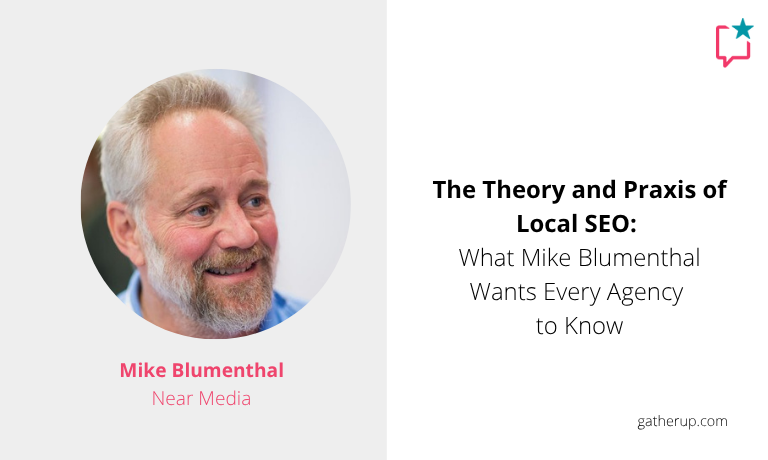
If you’re optimizing local listings, Mike Blumenthal has some blunt truths—and useful frameworks—you need to hear.
At AmpUp 2025, GatherUp co-founder and Near Media analyst Mike Blumenthal delivered a session that mixed high-level insight with street-level strategy. Titled Local SEO: Theory and Praxis, it wasn’t a “how to rank in the Map Pack” talk. It was a reset. A reminder that if you don’t understand the why behind the what, you’re going to waste a lot of time chasing shadows.
Here’s a breakdown of what Mike shared—and what you can implement today if you’re managing Local SEO at an agency.
Let’s Get Clear: What Is Local SEO?
Mike began by breaking Local SEO into two big buckets:
“Theory is how we think the world works. Praxis is how we act in it.”
He explained that most Local SEO advice is focused on praxis—tactics and execution. But if those tactics aren’t grounded in how local search actually works today, they’re not only inefficient—they can be wrong.
So what’s the goal of Local SEO? In Mike’s words:
“It’s not just about showing up. It’s about showing up when it matters.”
That means appearing for high-intent, geo-qualified queries that lead to action—not just getting found for the business name or broad terms.
The Core Truth: Google Is the New Home Page
Mike emphasized something he’s said many times:
“Your Google Business Profile is the new homepage. Most users never make it to your website.”
And it’s not just a talking point. It’s baked into user behavior:
- 90% of local discovery starts with a search, not direct navigation.
- Over 70% of customers make a decision based on what they see in the search result panel.

Which means: that GBP panel—your photos, reviews, business hours, Q&A, and category—is often the entire brand experience.
He shared a caution: “If you’re not managing the GBP like it’s your top conversion tool, you’re losing leads.”
Reviews Aren’t Social Proof. They’re the Product.
Here’s where Mike got spicy:
“People treat reviews like decoration. They’re not. They are the content. They’re your brand.”
He challenged agencies to stop thinking of review generation as a box to check. Instead, he framed reviews as dynamic, user-generated SEO fuel that does three critical things:
- Drives visibility (via recency and volume signals)
- Shapes consumer perception (via narrative and sentiment)
- Influences conversion (via social trust and expectation-setting)

He added:
“You don’t need more five-star reviews. You need more truthful ones. You want the story they tell to resonate with your actual customers.”
Pro tip? Don’t panic over a 4.5 rating. It’s more believable—and converts better—than a perfect 5.0.
Google Ranks Entities, Not Websites
One of the most contrarian (and useful) ideas Mike drove home was this:
“Google isn’t ranking websites anymore. They’re ranking entities.”
He defined entities as:
- Real-world businesses
- With defined categories
- Tied to geography
- Referenced consistently across the web
So what does this mean in practice?
- Structured data matters.
- Consistency of Name, Address, Phone (NAP) is still relevant—but not in the way it used to be.
- Citations don’t need to be obsessively built—they need to be accurate.
In Mike’s view:
“You don’t need 200 citations. You need 20 good ones and to not screw them up.”
Don’t Over-Invest in What You Can’t Control
Mike offered some hard-earned pragmatism:
“There’s a lot in Local SEO you can’t control. Don’t build your process around those things.”
What he means is: Stop wasting hours tracking ranking for keywords that fluctuate hourly. Instead, focus on things you can consistently influence:
- Review velocity
- Profile completeness
- Image freshness
- Local links and engagement
He added:
“Google’s local algorithm is like weather. You can plan for it, but you can’t predict every shift.”
The key is systems—not hacks.
Build for Trust, Not Just Rank
Mike emphasized that trust signals aren’t just conversion boosters. They’re ranking factors too.
He cited:
- Quality of reviews (not just quantity)
- Review response cadence
- First-party signals from tools like GatherUp
“Trust is an input. If Google sees consistent, quality engagement, it elevates your business.”
He encouraged agencies to build local SEO strategies that prioritize transparency and responsiveness:
- Respond to all reviews within 24–48 hours
- Use real photos—not stock images
- Keep business hours updated
- Be accurate in every listing field
“The more reliable your data, the more trust you build—with users and with Google,” he said.
Think Local Content, Not Just Keywords
One of the most actionable sections of Mike’s talk was about content.
He challenged the idea that local content has to be dry:
“People think local SEO content means listing your address 50 times. It doesn’t. It means writing for people in your community.”
Tactical examples he gave:
- Feature real customer stories in your blog
- Use reviews as social snippets on service pages
- Create resource content around nearby landmarks or events
The goal? Build relevance that reinforces your local entity.
Google Is Messy. You Need to Be Clear.
Mike ended the talk with a dose of realism:
“Google isn’t your partner. They’re your playground—and sometimes your opponent.”
His advice: agencies need to build processes that tolerate Google’s messiness:
- Algorithm updates
- Suspended profiles
- Feature rollouts and removals
“Expect volatility. Build systems that keep going even when Google doesn’t behave.”
The Local SEO Playbook (Inspired by Mike)
Here’s a simplified version of Mike’s theory-to-practice framework:
- Audit the Entity
- Is the NAP consistent across major platforms?
- Is the GBP fully filled out with accurate hours, categories, and services?
- Is the NAP consistent across major platforms?
- Invest in Review Health
- Are you requesting reviews consistently?
- Are responses timely and human?
- Do the reviews reflect the actual experience?
- Are you requesting reviews consistently?
- Optimize the Profile
- Are you posting updates?
- Do your photos look recent and real?
- Are attributes and categories accurate?
- Are you posting updates?
- Add Local Signals
- Are you linked from local press or partner sites?
- Do you sponsor or engage in the local community?
- Are you linked from local press or partner sites?
- Measure the Right Things
- Track impressions, actions (calls, directions), and conversions from GBP.
- Watch branded search growth.
- Monitor review velocity and sentiment shifts.
- Track impressions, actions (calls, directions), and conversions from GBP.
- Build Resilience
- Don’t build fragile workflows.
- Expect suspensions, glitches, and bugs.
- Educate clients that volatility is normal—results come from consistency.
- Don’t build fragile workflows.

Final Take: SEO Is Local by Default
Mike left the audience with a reminder:
“In most cases, local isn’t a niche—it’s the norm. If you’re not optimizing for it, you’re not optimizing.”
That means:
- Every agency should have a local SEO checklist.
- Every business with a location needs a strategy.
- Every marketer should understand Google not just as a search engine, but a decision engine.
And reputation? That’s no longer a signal. It’s a strategy.
Watch the full AmpUp sessions here
